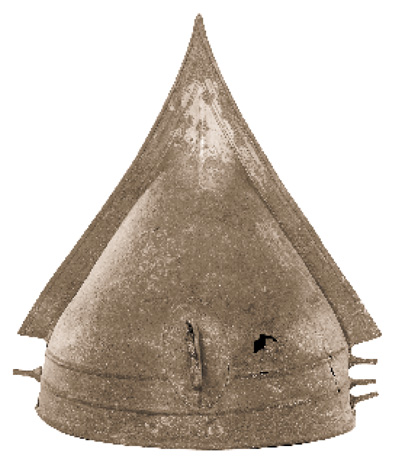
This sheet bronze helmet, which dates to around 1000 B . C ., was one of a hoard of nine similar helmets found in 1832 in Bernières d’Ailly, Normandy, in modern-day Calvados. The helmets had been
placed inside one another in piles of three, with the three piles arranged in a triangle and the crests of the helmets upright. The hoard was said to have included a bronze axe, a bronze spearhead, and two bronze bracelets as well, but these have disappeared.
A hoard is a collection of objects, often relatively intact and valuable, found buried together but not associated with a human burial. Some of the
hoards found near Normandy appear to have been votive hoards, containing objects offered for ritual purposes. Burying metal artifacts — axes, spearheads, and other items of bronze — in hoards was a common practice in the Late Bronze Age, especially in Atlantic and Northern Europe.
We know from burial finds that helmets like this one formed part of a warrior’s regalia, along with bronze swords, spearheads, shields, cuirasses, and greaves. Despite its martial appearance, the bronze of this helmet is too thin to have provided any real protection in battle. It was designed for display and when polished must have been a spectacular sight. It is composed of two sheets of bronze attached front and back by folding at the rim and riveting. The crest was made by folding the edge of one sheet over the other. The projecting attachments on either side are hollow and probably were designed to hold some kind of ornament, perhaps of horsetail. A lining of leather or other perishable material was probably held in place by rivets and small bronze bands; the holes for these rivets can be seen near the bottom edge. Bands on the interior may have held chin straps.
Was this helmet Celtic? Strictly speaking, no, for Celtic is a linguistic term. But it seems likely that some form of a Celtic language was spoken in northern France around 1000 B.C., so the wearer could well have used a Celtic tongue.
